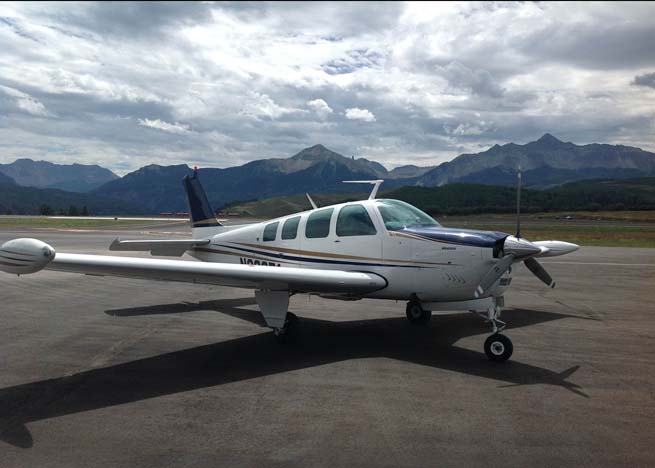
Add “one handheld radio” to Raymond Cody’s list of aviation gadgets to buy.
No need to add rush shipping to the order, however, because Cody, of Telluride, Colo., won’t be flying his aircraft again until August at the earliest. (The Beech Bonanza is down for maintenance right now.)
It would have been useful to have a handheld transmitter/receiver aboard on June 18. That was the day Cody experienced a complete electrical failure just after takeoff on a bumpy mountain flight from Telluride to Grand Junction.
On the other hand, then he probably would never have met his new best friend, Gene Manzanares, a Transportation Security Administration employee at the Grand Junction Regional Airport. Nor would Cody’s quickly improvised solution have livened up local TV newscasts and newspaper pages for the next few days.
Welcome to mountain flying, Ray.
When Cody’s electrical system quit during retraction of the landing gear, he couldn’t tell whether the gear was up and locked, down, or somewhere in between. All he knew was that the sound the gear was making while coming up wasn’t right, and seemed to stop too soon. As he was pondering that, the avionics quit.
Cody decided to press on to tower-controlled Grand Junction, where someone could look over his landing gear during a fly-by. But without a working radio, he couldn’t call ahead for someone to be in position when he arrived.
Complicating the decision to continue on was turbulence over the mountainous terrain between Telluride (elevation 9,070 feet msl) and Grand Junction Regional Airport (elevation 4,858 feet msl). Cody, a 1,200-hour pilot, only has about 90 hours of mountain flying time, he said.
There was also the question of what would happen when he tried to crank the gear down by hand for landing.
Time for some in-flight problem solving.
Navigating with an app on his iPad while holding onto the yoke with one hand and flipping pages of a flight guide with the other, Cody searched for a phone number—any number—at the Grand Junction airport.
He found one, but he was getting “hammered” so badly by the bumps that he couldn’t make out exactly what number he was calling on his cell phone.
TSA staffer Manzanares, at work in his office, heard a phone ring and went to pick it up.
“A guy answered,” Cody recounted for AOPA in, yes, a phone interview. “I told him the situation: ‘I’ve got a little emergency here, lost all my avionics and I just want to do a little fly-by.’”
Manzanares, a coordination center officer for the TSA, calmly assumed his new role of air traffic control intermediary, calling the tower on another line and relaying messages between the pilot and ATC as the details of the fly-by, and a landing clearance, were worked out. At some point about 20 minutes into the call, Ray and Gene introduced themselves.
The fly-by showed that the gear appeared to be down and locked, and Cody safely landed the A36.
The two men met the following day while the Bonanza was being serviced, with Cody quick to express gratitude for Manzanares’ potentially life-saving assistance.
Cody, a Telluride property manager, learned to fly 30 years ago in Kansas “where everybody is a pilot.” He returned to aviation within the past year, he said, stepping up from the Beech Sundowner he used to fly to the Bonanza.
Cody said he only felt some anxiety during his wild ride while searching for a phone number to call. After finding it, at 10 miles from the airport, and after hearing Manzanares’ voice on the phone, his jitters disappeared.
Looking back on his day, which began with a stuck hangar door, there had been some early indications of trouble. The Bonanza’s battery was dead when he attempted to start up. After getting an assist with starting, he spent some time charging the battery, he said, and at that point the radios seemed okay.
But when he tried to raise the landing gear after takeoff, the “winding noise” he usually hears during retraction seemed to cut off too soon—and then the avionics failed.
In the future, Cody said, he will make sure to check switches and note the system voltage before every shutdown.
With the airplane now in the shop for an annual inspection and a turbonormalized engine upgrade, he has some time to ponder other refinements and additions.
A handheld radio?
“It’s on my list,” Cody said.



